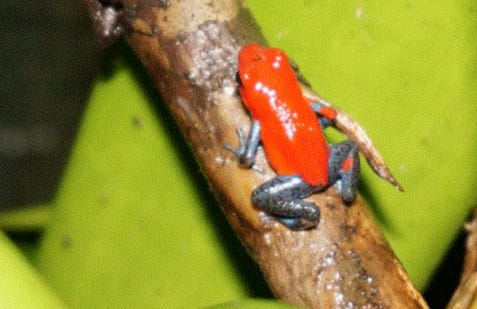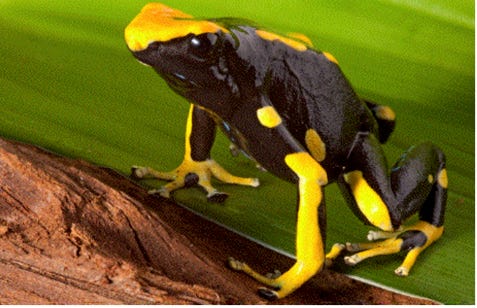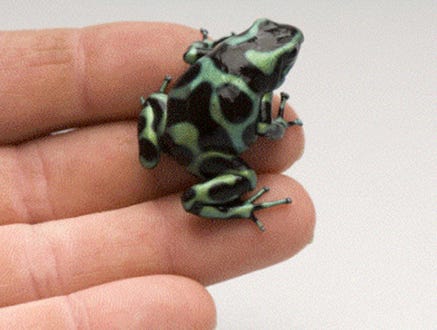THE GREATEST SECOND-CHANCE FROG QUEEN (Part 4)
About Dart Frog Poison (how it kills), and Queen Gertrude talks about a painkiller from frog dart poison 200 times more powerful than morphine. PS. FULL BOOK here: https://www.amazon.com/dp/B09QML8BQN
(I realize I may have skipped past just how the dart poison actually works to kill somebody. Here’s the info):
When the frog’s skin, which is coated with ’alkaloid’ poison, gets into a human bloodstream through a cut, it almost immediately renders the muscles inactive, which affects organs like the heart and lungs (which run off of muscle contractions). Three minutes is all the victim has, to say his or her fair and fond farewells.
But you want still more of an answer? You wonder how a toxin does its paralyzing? Well, it is a chemical. That much I can say. As for its ‘compound properties,’ here’s what has been researched.
What is stated by experts is, and I quote, “Batrachotoxin opens the sodium channels of nerve cells and prevents them from closing. The neuron can no longer send signals and this results in paralysis.” (From Wikipedia, subject: “Batrachotoxin”). I do realize that this description opens up a whole new kettle of fish. That’s because humans don’t usually think of their bodies as functioning from neuron to neuron.
Who could imagine that humans owe their daily lives to the operation of tiny, almost sub-atomic-sized chemical interactions, like how modern cars run mostly off of onboard computers. Now, I’ll have to get back to you about ’neurons,’ don’t I? Who says a old frog can’t learn new tricks!
Humans have neurons. So do rodents, ...every living anything; even frogs! A neuron is a type of cell that transmits messages between the brain and other parts of the body. It even has some level of electricity in it. So I have to assume that any critter that has a brain has these neurons telling its body parts what to do. Like, “Frog legs — start jumping!” Or humming bird wings — start batting! Snakes — start slithering!
Lately, scientists have been researching if humans have specialized neurons in their eyes that carry awareness (and fear) of snakes from ancient times. Even children who don’t have any experience with reptiles have such fears, they say. So possibly, neurons can carry information from generations past.
Scientists say the average human brain has 100 billion neurons or “nerve cells,” and more neuroglia cells, called “glial cells,” that help neurons and also protect them. At any rate, lots of neurons interact every instant of a living thing’s life, and “fire” when needed, helping us (that’s right, even us frogs) survive in our environments.
Just for comparison, an online chart I accessed (using my new i-frog computer!), says that we amphibians have just 16 million neurons to run info and impulses between our frog brains and frog bodies – sadly, a few less than humans. But we’re not at the bottom of the heap, neurons-wise.
A sponge has zero (too bad) neurons. Jellyfish 5,600. And a lobster’s 100,000 neurons must panic terribly as their tentacles hit the hot cooking water (ouch!). The typical house mouse has us beat with its formidable 71 million. How an octopus ended up with an astounding 500 million I’ll never know. A cat does a little better with 760 million, but the surprise of the neuron contest is the African elephant, bettering humans by more than double with their 257 billion neuron count. That’s why — and how — an elephant never forgets.
By the way, the phantasmal poison frog (a little different that its Golden/dart relative), has been used in tests to determine if its toxic properties can be used in creating an important pain killer. No success yet, but supposedly the chemicals from its skin delivers a relief 200 times more effective that morphine. It’s called Epibatidine. But research has halted because it is too lethal for any sound and safe medical adoption (so far!).
QUESTION: Is war nature’s way? Is killing others of your own species (but not even eating them afterwards?) natural? How many times a year do humans in America kill-shoot-maim each other and not even take responsibility for dealing with the carcass? The dictionaries don’t even want to ascribe the word ‘carcass’ to the human body, but prefer to label it slang, though it is fine for animals. In either case, a whole lot of humans croak each year (another interesting slang word, and closer to home...), from being dealt a death blow by others. How’s the number, 40,000 fatalities in the last year, strike you?
The numbers are getting bigger because of human’s incessant need to communicate almost every second to someone else, be it texting on their phone while they should be looking ahead at the next cars, instead of spending real time with their mate, their children, or just eating a meal. Frogs like to communicate too but, believe me, there are moments during the day and night when we aren’t croaking every damn second!
——————-
More on “the illogicalness of war between similar-looking humans (not between frogs…they just EAT each other for FOOD!),” coming up in PART-5.






